Gas + Stick: 5 New Sports Cars That Keep the Faith
Change is afoot. We all feel it. Even if electric vehicles aren’t meeting sales expectations at the moment, it’s not hard to wonder whether it’s closing time for the traditional sports car. At least, for those of us who don’t have millions to throw at one of Gordon Murray’s naturally aspirated, stick-shift hypercars. Fewer than 2 percent of all new cars sold in the United States last year had a manual transmission, and the options dwindle by the day. Many of our favorite cars are straight-up disappearing—a few months back, we bade goodbye to the Chevrolet Camaro with a series of articles—while others remain in name but leave us in spirit. The latest BMW 3 Series, for example, offers no manual transmission except as a $76,000 M3/M4; the Volkswagen GTI currently has three pedals but will not for 2025, and it will likely go all-electric in 2026.
Indeed, as I was readying the new-for-2024 Ford Mustang you see here to participate in the story you’re about to read, I got a text from my father informing me about the purchase of… a 2024 Mustang GT. Although he has owned his share of sports cars over the decades, there seemed to be an urgency this time around. “It could be my last opportunity to buy a new car like this,” he explained.
The desire to seize the present as well as wring the last few drops of driving season carried us to southern Ohio in late autumn in five sports cars you can buy right now, including the Acura Integra Type S, the Mazda Miata, the Subaru BRZ, and the Toyota GR Corolla, as well as the aforementioned Mustang GT. Our aim wasn’t a conventional comparison test, so our qualifications, aside from the need for a clutch pedal, were unapologetically fuzzy.
We wanted cars that could be had for around $50,000 (roughly the average price of a new car in 2023, believe it or not) and that represented some niche of sports car enthusiasm. And rather than a rigid rubric of track and performance testing, we opted for a backroads adventure someone might reasonably do in a factory-warrantied, bank-owned daily driver. Our goal, in essence, was to understand the state of the affordable sports car in 2024. Is this really the end? Or, worse, has the best already come and gone?
The Purebreds
2023 Mazda Miata Grand Touring
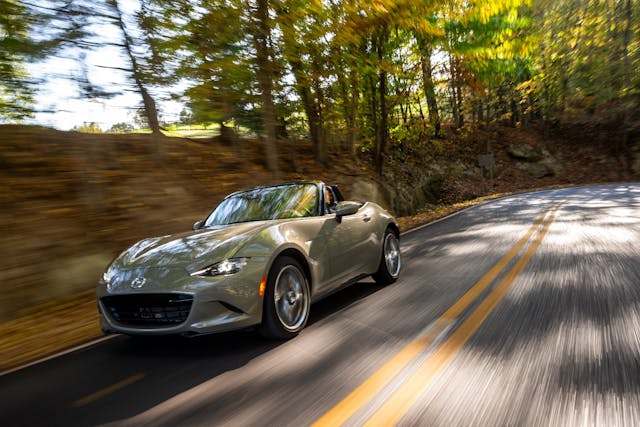
One of the things no one tells you about Ohio is that it’s beautiful. South of Columbus, the midwestern monotony of cornfields and industrial sprawl gives way to red-streaked rock, winding waterways, and ribbons of perfect blacktop that dip and careen through a multicolored forest canopy. We set out in the early morning from the town of Athens, home of Ohio University and situated along the Hocking River. Although it was cold enough to frost, I flipped open the top of our Miata to let in the morning mist.
The Miata is the oldest vehicle in this test in more ways than one. It was last redesigned in 2015, an eternity in the auto industry, and differs in no meaningful way from what Mazda introduced in 1989. It also represents our very oldest notion of what an affordable sports car is—a two-seat, rear-drive convertible with an overachieving four-cylinder. In the 1950s, these arrived on our shores as MG TDs, Austin-Healeys, and Triumphs.
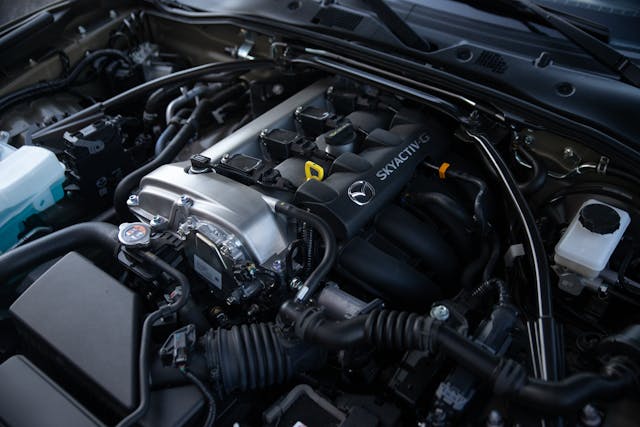
If your senses have been dulled by modern performance cars with their rock-hard suspensions, steamroller tires, and Ludicrous settings, you might spend a mile or two wondering what all the fuss is with the Miata, in the same way my 4-year-old daughter was unimpressed by her first real rainbow sighting (“Where are the unicorns?”). This Miata has more power than any of its predecessors, edging out even the turbocharged 2004–2005 MazdaSpeed Miata. But given the massive horsepower inflation of recent years, it doesn’t feel particularly muscle-bound. Even for me, a longtime owner of a first-generation Miata, the initial meeting here is slightly awkward. Steering is relatively light, and the ride is luxury-car supple. Through the first few corners, supposedly this thing’s calling card, I sawed at the wheel, jabbed at the throttle, and was rewarded with a whole lot of body roll and slower corner exits.
Then I settled down, slowed my inputs, and devoted more of my energy to seeing and sensing the road. It clicked. The car stopped fighting me—or, rather, I stopped fighting it—and we started experiencing each corner as a team. With smooth braking and deliberate turn-in, the Miata sets, sticks, and gently pivots. Feed in throttle, let out a small whoop, and prepare for the next one. The Miata isn’t just a good driver’s car but also one that continually teaches you to become a better driver.
This has always been the Miata magic, but that magic has been distilled in the latest edition. Three of the editors on this test, myself included, own first-generation cars, and we all remarked on how this one actually feels better. “It’s every bit as agile as the original but is so much more composed when you go faster,” said editor-in-chief Larry Webster (who technically owns two old Miatas). “It’s light and flickable, graceful. The motor kept its zinginess but has the muscle the first one lacked.” On top of all that, it has become considerably more practical, with an easier-to-stow and quieter top.

Of course, there are still practical limitations. Most of us could not justify a two-seater as a daily driver. “I would wait to get a Miata until later in life; in my 20s, I only want to keep track of one car, and I want something with more trunk space, if not more seats, and a hard roof,” noted associate managing editor Grace Houghton. Taller drivers, Webster included, had to accept being cramped.
These aren’t really criticisms, exactly, in the same way it’s not really criticism to say a hammer isn’t good at drilling holes. We’ve become accustomed to cars that attempt to do a lot of things at varying levels of competency. The Miata is one of the last cars on the road that tries to do one thing well. It is a sports car boiled down to its essence. On the right roads, it’s impossible to imagine wanting anything more.
2023 Subaru BRZ Limited

Unless, maybe, you hop directly into a Subaru BRZ, as I did for a stretch of Ohio State Route 537, a rural roller coaster dotted by the occasional farm and Parks General Store. (“You terrorists?” a local asked before driving off, apparently uninterested in our answer.) The Subaru’s chassis is noticeably and usefully tauter than the Miata’s, to the extent that you can hit the same undulating curves harder, brake slightly later, and jump on the gas a bit more aggressively. The general experience is similar, but there’s more adrenaline here.
If you’ve spent time in the first-generation BRZ and dismissed it—as I had—the second generation deserves fresh consideration. The boxer engine, which was breathless and harsh enough to knock loose a filling in the original, has been smoothed; it revs freely and has been given extra oomph. The gearbox is slicker, if not quite as silky as the Mazda’s, and the steering is nicely weighted and direct. “This is a ‘sweet spot’ car,” said Webster. “Enough power so you can wring it out but not so much that you’re going insanely quick.”

There are still some rough edges. The interior is, as ever, a sea of dark plastics, with a touchscreen that reminded one editor of a “10-year-old Android phone.” The busy exterior styling checks all the sporty boxes—and presumably satisfies the brand marketing departments at both Subaru and Toyota (which badges it the GR86)—but fails to strike much of an emotional chord. “As a design, it’s just not that memorable,” said HDC magazine creative director Todd Kraemer.
Yet none of these flaws meaningfully take away from what was, for only $31,500, the purest handling car in this entire group. “You get what you pay for here—and you’re paying for the chassis,” said Houghton, who named it her top choice. By my reckoning, you’d have to pay $70,000, the base price of a Porsche 718 Cayman, to get a significantly better chassis.
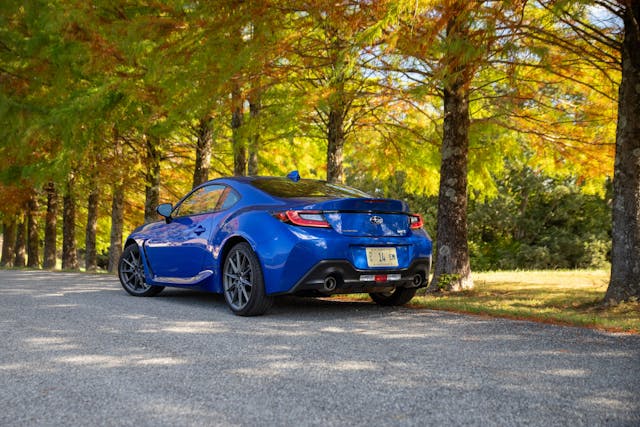
Indeed, it wouldn’t surprise any of us if, someday, enthusiasts shell out big-time money for the BRZ, as they do today for the best handling Japanese coupes of the 1980s and 1990s.
“This is one of those cars we currently take for granted,” noted senior content manager Joe DeMatio, “which, when it’s gone, we will be like, ‘Oh damn, why don’t they make that anymore?’”
The Sport Compact Generation Gap
2023 Toyota GR Corolla
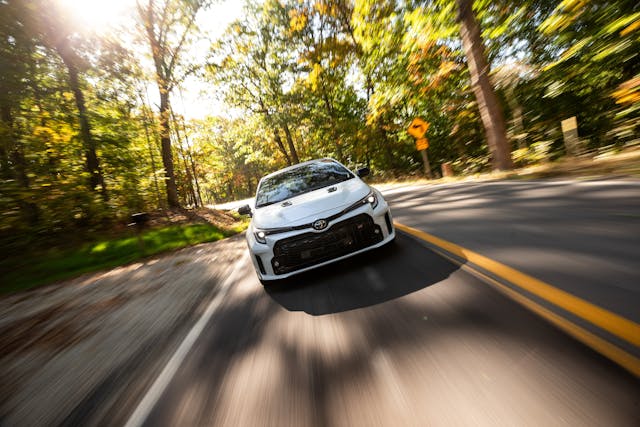
Stopping for lunch in one of the one-street towns around these parts, I spied a teenage boy gesticulating at me. Had I parked in the wrong spot? Run over his dog, perhaps? Only as I got closer did it become clear that I had spotted in the wild what is supposedly the rarest of creatures: a young person who is really into cars. Not just any car, though. He was drawn to the GR Corolla.
If, like me, you happen to be a middle-aged geek, this might seem odd. After all, we are talking about what is recognizably a Toyota Corolla hatchback. Chris Stark, associate editor and our own tame 20-something, attempted to explain the appeal: “Colin McRae ASMR 10 hours.”
Um, what?
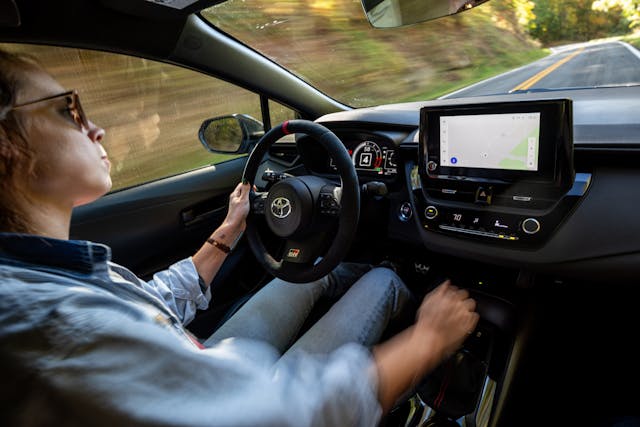
“You know, Colin McRae, the Scottish rally driver who is most famous for driving Subarus in the 1990s,” he enthused. “And ASMR stands for autonomous sensory meridian response—a tingling feeling down your spine in reaction to certain sounds. There are a ton of long YouTube videos about it, but basically, this Corolla makes really cool rally car sounds.”
I still don’t quite get all that, but within the first few miles, I appreciated the sheer chutzpah of this Toyota. Beyond the styling—an adolescent fever dream replete with fender flares, scoops, and three exhaust tips—it has the most unsubtle turbocharger I’ve experienced on a new car in at least a decade. How else can a 1.6-liter three-cylinder make 300 horsepower? Each dip into the throttle is rewarded with a RIGHT NOW wallop of boost and neck-snapping thrust. “It’s just so scrappy and energetic,” remarked Webster. “You can’t not flog it.”
When the flogging ensues, you begin to realize there’s a lot more going on here than simply a pile of performance parts. For the uninitiated, “GR” stands for Gazoo Racing, Toyota’s in-house motorsports outfit. It has been particularly active of late in World Rally Championship, winning the manufacturers’ title three years running. Our test car was a limited-build Morizo edition, that being the nickname of company chairman Akio Toyoda. It evinces all kinds of engineering overkill, from a lighter, carbon-fiber roof to extra spot welds (349, to be exact) that add rigidity. It is, in short, the real deal, and it drives like it. “The new hot hatch benchmark,” enthused Webster.
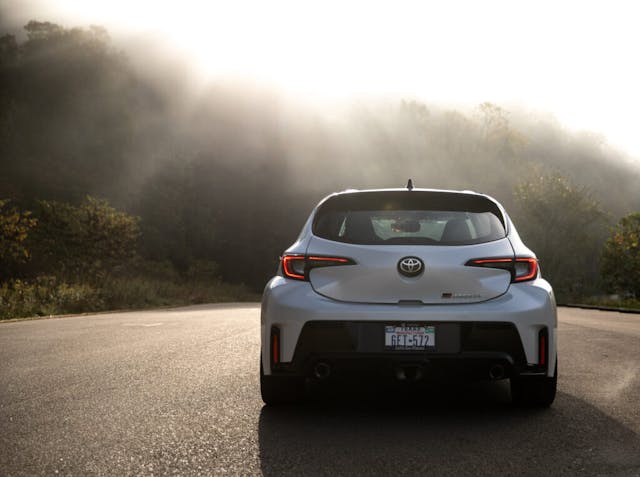
The car hoovered up the gnarliest corners Ohio could throw at it, going faster than the other cars in the group, always whispering for more speed. Unlike many all-wheel-drive wündercars, though, it never gives the impression that computers are doing all the work. Toyota paid attention to the ABCs of driver involvement, starting with a great manual gearbox. “The clutch pedal to shifter relationship is spot on,” observed DeMatio. “You can feel the texture of the pavement through the steering wheel,” added Houghton. The tires, Michelin Pilot Sport Cup 2s, have phenomenal traction but let you know when they’re reaching their limit, rather than braking suddenly. “It was confidence-inspiring on a level unmatched by any car in our group,” concluded Webster.
It was also, without a doubt, the most tiring car in our group, with a bone-rattling ride and a never-ending cacophony of road, engine, and wind noise. “I’m told the Morizo version has a lot of the sound deadening removed—put it back!” groused Kraemer. Even Stark, who spent much of the trip trying to figure out what he could Marie Kondo out of his life in order to afford one, admitted there were moments when it was all too much. “I love this car, but I’m glad I wasn’t the one who drove it back to Michigan,” he said.
2023 Acura Integra Type S

The car most of us preferred to while away the hours in was the Acura Integra Type S. Before going any further, let’s take a moment to appreciate that there is such a thing as a new Integra Type S. The nameplate disappeared in the United States around the turn of the century, and Acura hasn’t offered a small sport compact of any kind in more than 15 years (the outgoing ILX had its merits but never had sporting intentions). Zooming out, there just aren’t many new cars (as opposed to crossovers) of any ilk being added to lineups these days, let alone hatchbacks with stick shifts and 320-hp turbo engines.
That said, for better and for worse, this is not the Integra of millennials’ nostalgic imagination so much as the Integra for millennials as they exist today—30-somethings with respectable jobs to get to and families to haul. The model-year 2000 Acura Integra Type-R, now a darling of the collector car market, was in many respects a tuner special in the spirit of the Corolla GR. The Type S, although essentially a Type-R under its skin (most of the mechanicals come from the Honda Civic Type R), hews closer to the tradition of the Volkswagen GTI: a subtle, refined front-driver.
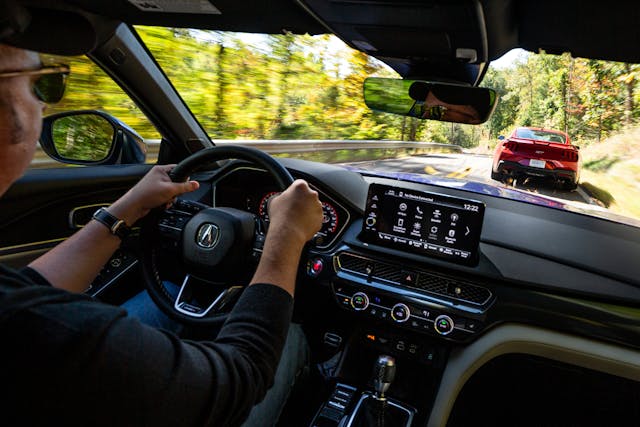
Most of the time, this felt like a pretty smart balance. “The right car for me,” said DeMatio. “Plenty of power, but also plenty of refinement and an attractive exterior. All the stuff you’d expect from a daily driver—easy-to-use interfaces, excellent outward view, comfortable seats—is here.” Much like in the best GTIs, when you spend enough time in the Integra, you start to wonder why anyone would ever need anything more. Moreover, everyone appreciated the aggressive styling, which is frankly astonishing when you consider how polarizing Acuras have been over the past decade or so.
Driven by itself on these roads, the Integra feels nearly ideal, with no shortage of power or traction and a manual gearbox as good as any Honda has produced (which is to say as good as anyone has produced). In our group of purebreds, however, the trade-offs become clear. The steering wheel tugs noticeably under acceleration and generally lacks a consistent feel. “It’s darty just off center and then overly slow as you turn in further,” complained Webster. “I found myself making numerous little corrections.” The engine is better behaved, producing nary a hint of turbo lag. Yet some of us would have preferred some rowdiness. “Where’s the VTEC, yo?” wondered Stark.
More than any of the other cars on the test, this one seemed haunted by memories of what used to be. It is neither the zippy boy racer of Acura’s past nor the perfectly balanced sports sedan that, not long ago, seemed to be price of entry for every serious luxury brand. “I thought the car might make me sell my E36 1998 M3 four-door,” mused Webster. “Nope.” But our memories can play tricks on us. When we turned our focus to the present, the Integra was the car more editors said they wanted to take home than any other.
The Pony Car Stands Alone
2023 Ford Mustang GT
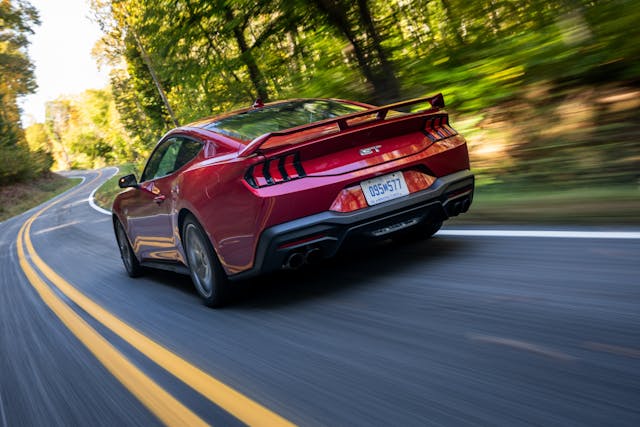
There are many things that distinguish the Ford Mustang from the other cars in this test. It was the largest, the most powerful, and (as equipped) the most expensive. It wears the oldest nameplate, too—60 years, as of this April. Not for nothing, it’s the only one in our group sold by an American automaker (although it should be noted that the Integra is in fact built right here in Ohio). But the most important distinction, in terms of understanding the Mustang, is that people buy it in meaningful numbers. Ford still sells some 50,000 a year in the United States and boasts that it has been the bestselling sports car in the world 10 years running. The new seventh-generation model is so hot that it’s sitting on dealer lots for an average of just seven days. Like the Rolling Stones, it somehow manages to keep drawing the crowds.
This popularity makes it an exception among affordable sports cars. Yet it is an exception that proves the rule, for the most popular sports car in the world is—at least in the particular context of this group and these tight country roads—not exactly a sports car.
Please don’t misunderstand: The new Mustang is effortlessly fast, and it sounds the business. “Easily the best sounding car here,” enthused Stark. Around town, the 5.0-liter does a convincing impression of an old-time big-displacement engine, but it really sounds best at high rpm, where eight cylinders combine with four fast-spinning overhead cams in a symphonic roar. True to form as the last muscle car standing, it also does, per Webster, “the best burnout of any modern car.”
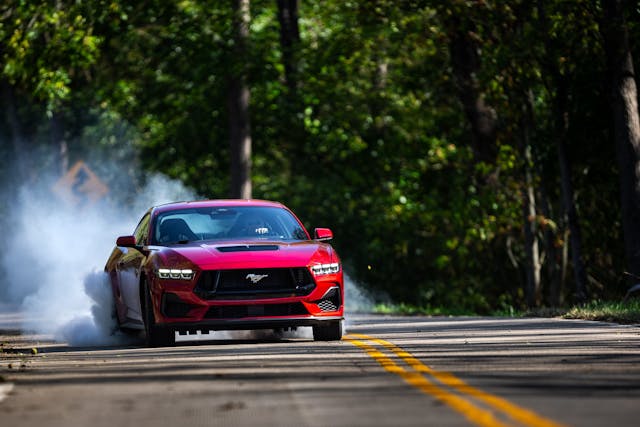
Despite its size, it had no problem keeping up with the others, even through technical sections where it couldn’t rely on its massive power. If only it felt a little more joyful doing so. “The steering is lifeless, like a racing simulator,” said Webster. Admittedly, that’s a trivial complaint in most driving situations. Charging over a blind crest or dialing downhill into a decreasing radius corner, though, this sensory deprivation can be downright spooky. You have to trust that the tires are somewhere out there and indeed sticking to the pavement. Mind you, the Mustang consistently proves worthy of that trust. “It did what I asked every time and compensated when I made mistakes, so the suspension and brakes were doing their job,” noted Kraemer. “You just didn’t always feel like they’re going to do their job.”
None of this is surprising nor, really, an indictment. The resounding majority of modern performance cars, including the Porsche 911 and pretty much all new BMWs, have grown larger and feel more isolated from the road than their predecessors, presumably because that’s what most of us want. Heck, it’s what most of us wanted most of the time—the Mustang, along with the Integra, was the car editors most desired for the stretches of “normal” roads that connected the technical bits. “I imagine it’s a fine commuter car for someone who’s got to burn 50 or 75 miles of freeway every day,” admitted DeMatio.
What saves the Mustang as a sports car—what has almost always saved it—is that it doesn’t take itself all that seriously. Everyone geeked out over the fact that among the optional gauge configurations in the digital driver’s screen is a tribute to the tach and speedo in a late 1980s Fox body. “All the bells and whistles on the dash are pure fun,” enthused Kraemer. Most were charmed by the return of a handbrake (even though it’s actually connected to the e-brake by electronics, rather than a cable). And everyone loved the way it looked—even those of us (me) who had balked at the initial photos. Using the basic retro styling language that has served this car well since 2005, Ford designers came up with something more expressive and almost cartoonish—in a good way. More than any of the other cars in our group, the Mustang has a personality and a presence. “It reminds me of a Labrador—big, dumb, loud, and eager,” said Stark. It was hard for any of us to be angry with the pup for being out of its element on this drive.
“This thing does all the Mustang stuff—it just might be too soft for what we want to do out here,” concluded Webster. “I’ll reserve judgment until I drive a Dark Horse.”
It turns out the automotive industry, which has by and large converged on the front-drive-based, SUV-like wagon as the Universal Transportation Solution, still produces (at least) five wonderfully different answers to the question, “How can I have fun in a new car for $50,000 or less?”
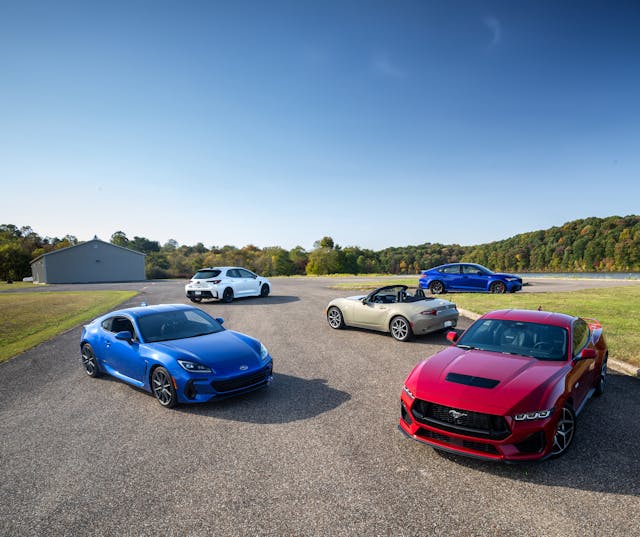
Those differences make disingenuous any attempt to declare one car the absolute winner. Indeed, the vote was irreparably split. DeMatio and Kraemer preferred the Integra; Stark naturally fell for the Corolla and Webster seemed to be with him, albeit with the caveat that it might be “too stiff and annoying in everyday use;” Houghton picked the BRZ; photographer Cameron Neveu, freed from camera duty long enough to get seat time in each car, lent his support and a huge grin to the Mustang; I’d soonest put a payment down on the Miata.
We tucked in for the night in Marietta, Ohio (population: 13,178), the oldest settlement in the former Northwest Territory. Situated at the meeting point of the Ohio and Muskingum rivers, Marietta was long a choice spot for indigenous tribes—as evidenced by large burial mounds—and later became a nexus of shipping, railroad, and oil wealth. In recent decades, though, it has faced economic challenges all too common throughout the Midwest, and many of its stately buildings sit empty or in disrepair. Spend enough time in towns like this, and it’s hard to escape a sense of loss, a nagging sense that we’re closer to the end of something than the beginning.
Perhaps it was the afterglow of the day’s driving, but I chose, on this night, to see it differently. This place is still here. The work of generations—the broad boulevards, the rows of massive trees, and the 18th-century mansions—is still here for us to appreciate on a clear autumn night in the 21st century.
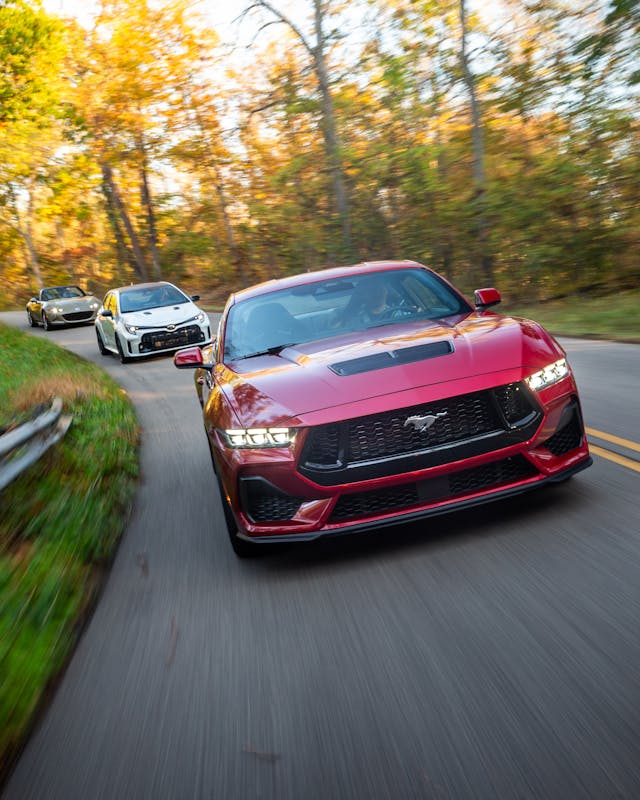
I suggest we choose to take the same view of the affordable sports car, which has, truth be told, been dying for about as long as it has been alive. In the 1950s, the decade many associate with the emergence of the sports car in America, it faced extinction from the proliferation of driving assistance technologies like power steering and automatic shifting. (From 1950 to 1960, manual-transmission take rate in the United States dropped from two-thirds to less than a third.) In the 1970s and ’80s, fuel crunches, safety regulations, and insurance hikes doomed the muscle car and sent British sportscar makers into a tailspin. In the 1990s and early 2000s, sporty coupes were supposed to be supplanted by SUVs.
Now they face the rising threat of electric vehicles. What else is new? That’s not some bromide about how the best is yet to come. But I can say that at this very moment, affordable sports cars are still with us, and people, they are very good. If you’ve dreamed of one, there’s no time like the present. Dad’s right—don’t wait.
***
__
Specs: 2023 Mazda Miata Grand Touring
Engine: 2.0-liter I-4
Power: 181 hp @ 7000 rpm
Torque: 151 lb-ft @ 4000 rpm
Weight: 2341 lb
Power to weight: 12.9 lb/hp
0–60 mph: 5.7 seconds
Base price: $29,300
Price as tested: $34,500
__
Specs: 2023 Subaru BRZ Limited
Engine: 2.4-liter H-4
Power: 228 hp @ 7000 rpm
Torque: 184 lb-ft @ 3700 rpm
Weight: 2864 lb
Power to weight: 12.6 lb/hp
0–60 mph: 5.4 seconds
Base price: $29,600
Price as tested: $31,500
__
Specs: 2023 Toyota GR Corolla
Engine: 1.6-liter I-3
Power: 300 hp @ 6500 rpm
Torque: 295 lb-ft @ 3250 rpm
Weight: 3186 lb
Power to weight: 10.6 lb/hp
0–60 mph: 4.9 seconds
Base price: $37,000
Price as tested: $52,100
__
Specs: 2024 Acura Integra Type S
Engine: 2.0-liter I-4
Power: 320 hp @ 6500 rpm
Torque: 310 lb-ft @ 2600 rpm
Weight: 3219 lb
Power to weight: 10.1 lb/hp
0–60 mph: 5.1 seconds
Base price: $52,000
Price as tested: $52,000
__
Specs: 2024 Ford Mustang GT
Engine: 5.0-liter V-8
Power: 486 hp @ 7250 rpm
Torque: 418 lb-ft @ 4900 rpm
Weight: 3827 lb
Power to weight: 7.9 lb/hp
0–60 mph: 4.2 seconds
Base price: $45,000
Price as tested: $61,700
***
Check out the Hagerty Media homepage so you don’t miss a single story, or better yet, bookmark it. To get our best stories delivered right to your inbox, subscribe to our newsletters.
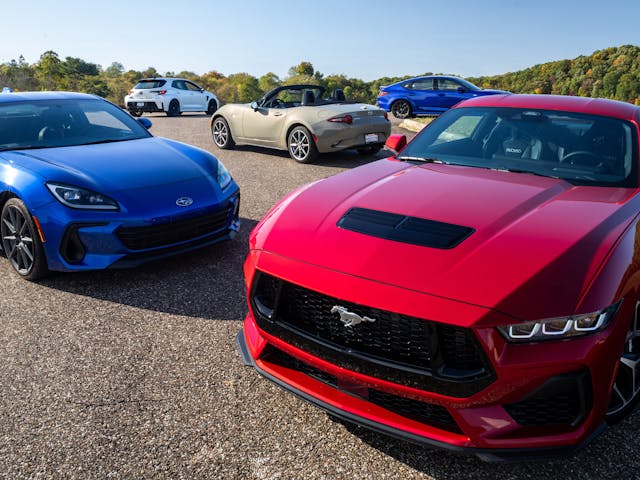
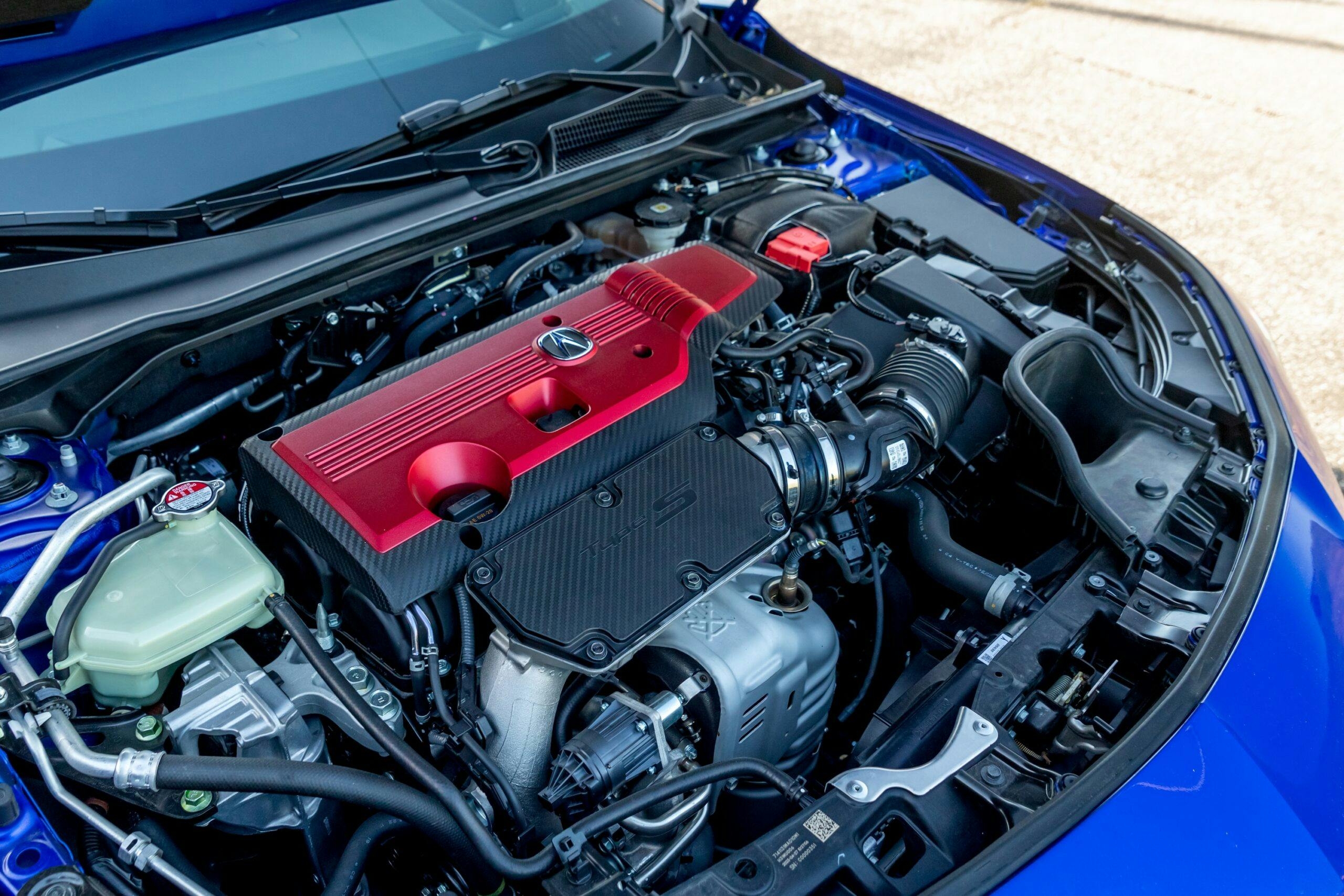
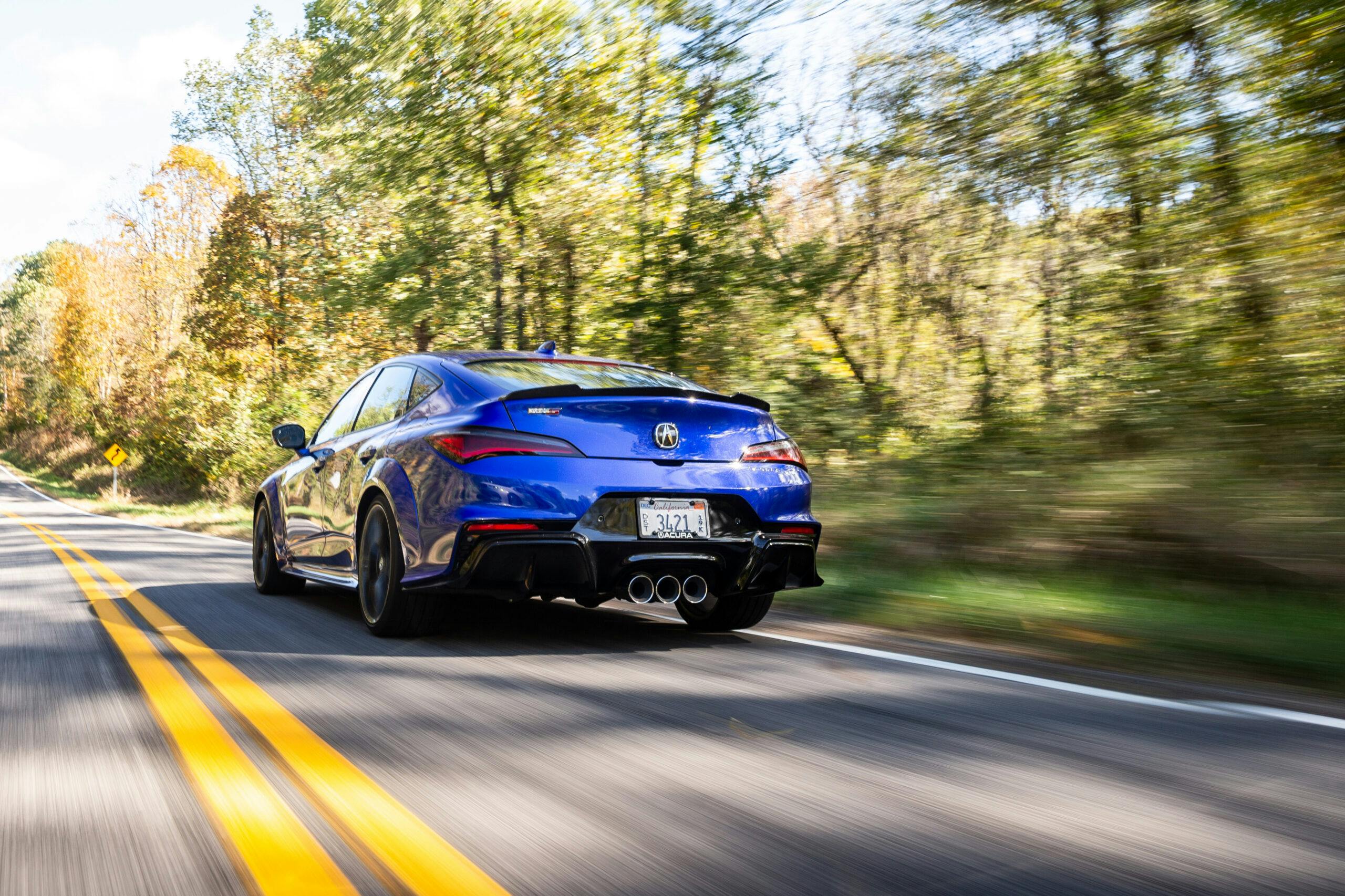


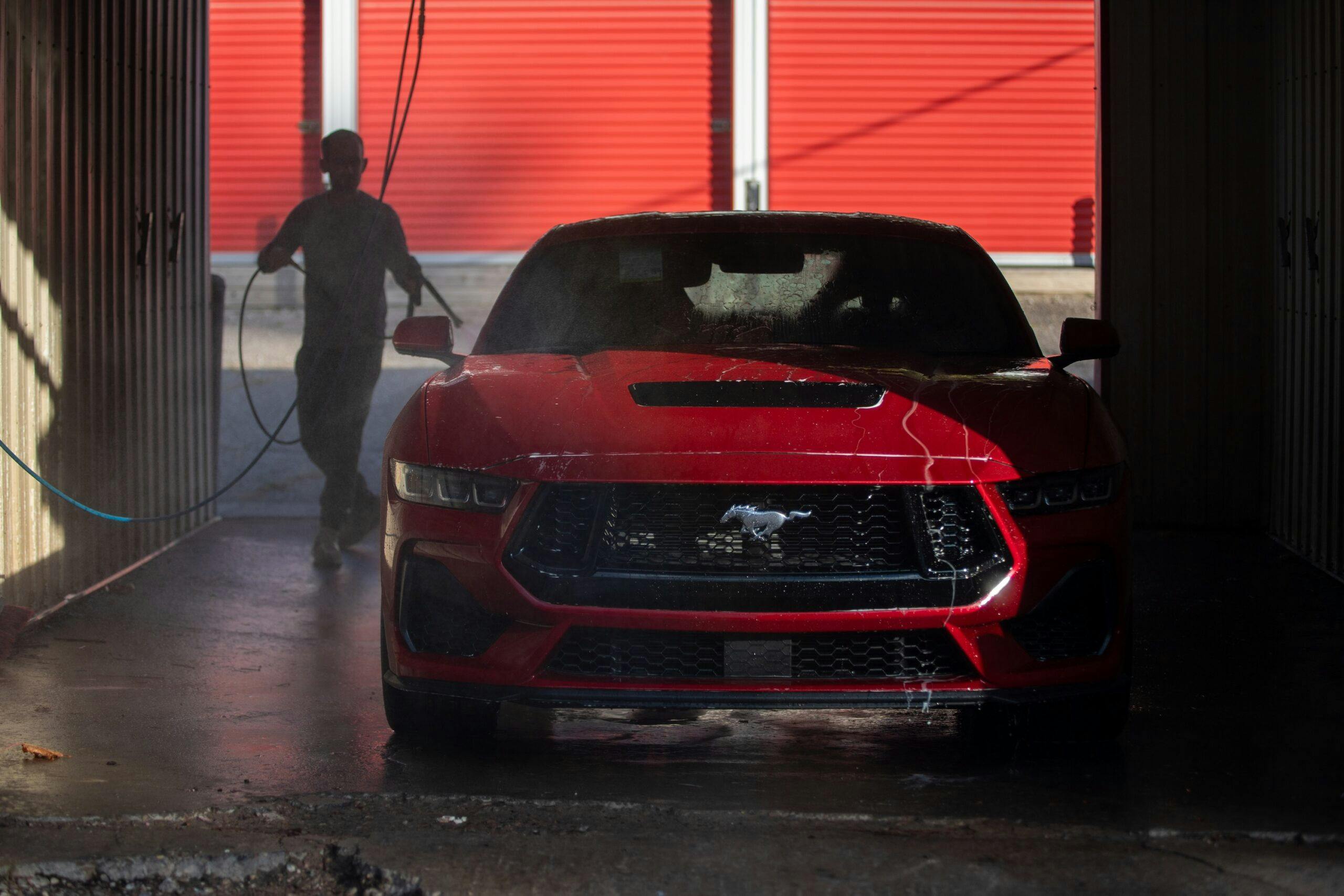


Smoke em while you got em!.
I suspect that these are dead cars walking The future for stick is limited and in some cases these cars may not survive much longer as they presently are and take on a different take if they are to survive.
those aren’t sports cars, they are sedans…if a car does not have a clutch, it is not a sports car….
They all had a clutch pedal, though the traditionalist might call the Miata a sport car, and the Mustang, Acura “GT” cars. The BRZ is a coupe sport car. The GR Corolla is a hit hatch sedan, or a rally special (much like my R5Turbo 2). Which is best? I am in the market, have driven all, and have yet to make a decision. Since it will likely be the last time I have a chance to purchase something like this new, I tend to favor rear wheel drive, love V8s but also light weight and engaging handling characteristics. Hmm… Alfa Giulia?
Starting to see collector car dealers loading up on newer Muscle. Thinking a guy should get his hands on as many V8 Stangs, Camaros and Challengers with manuals as possible for investments. Stocks and gold are boring!
Your comment has me thinking about the folks who paid huge premiums to put 1978 Corvette Pace Cars and 1990 ZR-1’s away as “investments”.
Paul, I bought a ’76 Corvette, new from a very small town dealership. Two years later, they called to tell me of a limited edition Corvette for ’78 and did I want it? I agreed to an MSRP purchase before the car had even been built. Of course, people went a little crazy. I bought the car with my own buyer standing in the lot. Paid for it with a hot personal check, sold it for a $5,000 profit and took my buyer’s cashier’s check to my bank to cover my purchase check. I am so glad I wasn’t even tempted to put it away as an investment.
A couple things: I had to use my AI copilot to look up Marie Kondo and who she was (is this common knowledge or am I getting old?).
I’m glad to know you car journalists put your money where your mouth is by actually owning cars that you highly regard (three of you own Miata’s? That’s cool).
And the “…it’s hard to escape a sense of loss, a nagging sense that we’re closer to the end of something than the beginning…” was an awesome analogy to the end of these kinds of cars.
Nice article.
Indeed, an awesome analogy. And it sometimes also seems to be true in the broader world outside of sports cars, sadly.
My next car will be a streetable track car. I should probably find something older to start with but I don’t really want to deal with the unknowns of a used car nor the wear and tear. Which doesn’t leave me with a whole lot of options these days.
The Civic Type R is under consideration. It’s a Honda, and I’m generally a big fan of theirs. I’ve raced or tracked FWD all my life so there’s little learning curve from that standpoint. But the latest cars are expensive for what they are and they’re kind of big and heavy. The BRZ/GR86 twins are definitely on the list. Attractive, reasonably light and a good start in terms of performance. The hangup with them is all the noise around blown motors. It’s hard to tell if that’s real or just internet noise and idiot drivers. Maybe I should just go for it and drop a K-Series in it if the motor goes south? The Miata is in the ball game but very peripherally. I love the NC but it hasn’t been in production for 10 years and I don’t hold out much hope of finding a used one with just a few miles. The ND wouldn’t be so bad but it looks awkward with a hardtop, which would almost be mandatory (Along with a roll bar) I drove a friend’s but I didn’t really love it. I will never be a Mustang person so that’s a non-starter. So what’s that leave? My current first choice is a Caterham Seven 420R. Simple, light and ultra quick. The main down sides are cost and the lack of sheetmetal around me while driving it. Come spring I will decide which direction I want to go in.
If Toyota put the Corolla GR engine in the BRZ I would probably instantly go for that…
Agreed – the thrilling performance of the GR, without its goofy looks.
I was once in the market for a steerable (daily driver, in fact) track car. I started with a new Fox Mustang “sedan” (aka: Notchback), from Saleen. I then tossed everything and developed my own track package, and found that it was indeed road worthy, and kept it for 16 years, 8000 track miles and 123K total miles. Sold it 16 years ago, and it recently sold on BaT for $76K. Still a daily driver track specialist.
Today, just buy a Mustang with the track package that includes the diff cooler, get some really good double adjustable dampers, and maybe some bushings from Global West (if the stock Mustang is doing anything that you don’t like handling wise) and you will have what you want. If you go the 7 route (I have done that as well), you will find much fun both on the track and in the canyons. You may also spend more than the Mustang unless you purchase a properly prepped 7, which will run you around $35K or more, with more limited daily usage, cause, you know, no top, windshield, doors, and the exhaust next to your ear.
If you go with a new car, expect to spend between $50~60K. If you go to a used car, expect to spend about the same as you try to figure out the best package that makes the car work the way you might like.
I did forget one car… Camaro SS 1LE with the 6 speed. Track ready. Nothing that you need to do, and still around $50K. However, now out of production, unless you can find one left over. The best of its type. You don’t need the blower or the huge wing or any of that other stuff that pushes the cost up. Just a straight SS with the 1LE package.
I paid 69K for my 2022 ZL one Camaro. No track pack so no huge wing. The magnetic ride is really super. I use it as a street car I can take to the track… they will be available as used cars for the next 3 to 5 years probably in the price range you are talking about
Surprised that the Civic Type R and the WRX didn’t make your list. While people lament the softening of the WRX, for me it still represents practical fun on a budget.
You know the sportscar is in a dismal state when you have to throw things with 4 doors and a tailgate into the mix.
agree
Totally agree! When did we surrender our hot rod cards by buying four doors? I know, I know – there are some fast factory four doors out there and no, I don’t want to find out if yours is better than mine, None will darken my garage doorway. My last four cars – ’99 Jeep Wrangler, ’04 Corvette, ’72 Mustang Fastback, and 72 Nova – are all two door vehicles.
I was thinking that Acura was pretty far away in the picture. Unfortunately, it’s still not far enough to let me forget it’s only available in 4-door. What I find more interesting is that it’s still only a few pounds off the GR Corolla, which albeit its tiny appearance is surprisingly hefty
No Z? No Supra? Two of the biggest enthusiast name plates return, with manuals, and not even a mention? For that matter, no Elantra N? No Civic Type R? This is what I don’t get about automotive rags waxing faux-nostalgic about “oh no, the sports car is dying, all people buy anymore is crossovers.” Wrong. This is the best time to be in the market for an engaging car.
Also: manufacturers could totally put manual transmissions behind EV drivetrains, they just chose not to.
Right. The EV manufacturers choose not to add several hundred pounds of useless and expensive metal to their cars.
No WRX?
The fact is EV cars only need one gear to function so there’s no actual need for a gearbox. Electric motors by definition produce maximum torque from zero rpm and can rev to 20,000rpm, therefore one gear covers everything. Average ICE cars have useful ‘normal’ operating rpm ranges from around 1500 to 5000 rpm and relatively poor torque down low – therefore need several gears to keep the engine in its efficiency range. I sound like I’m an EV fan but I actually despise them. The so-called benefit to the environment is the greatest lie of our time, plus they’re just an appliance. About as exciting as a toaster. I’d take a living breathing ICE car with manual transmission, like the cars you mentioned – any day of the week.
“Sports Car” or a “GT” always a slippery slope. I call a corvette a sports car (only 2 seats) but a Mustang is a GT. Seating for 4. Both have AC and nowadays lots of accessories. I live in a TR6 and TR3 world. True sports cars.
Richard; I’m with ya…
The newest sports car in the pile is a ’69 Corvette. If I want to go British, there’s a TD in the mix.
For when turn signals and glass side windows seem a bit excessive….
You might want to instruct your models on the proper way to hold a steering wheel. Hagerty should be setting a good example.
What is wrong with them? I looked at each driving photo, and all looked fine, considering that one needs to take a hand from the wheel to shift gears.
You had around $50K as an entering argument, but 3 of these 5 top out over that number “as tested” – the Mustang at $61K! I’d much rather have two Miatas (one new for the road, one older for tracking) than a single new Mustang.
Sad days coming for us 3-pedal fans. I ordered my 2015 MINI Cooper S as a 6-speed, and have no intention of selling. And for days when pavement is dry and temperatures moderate, I prefer my 2002 Boxster 986S, also 6 speed. I have long said that if something happened to either, I’d take the insurance money and sell the survivor, and find a 6-speed 981 Boxster S. Of course, that’s plan Z. Plans X and Y are to drive both, happily. I have driven manuals for well over 50 years, and truly detest automatics.
I felt the same way until I had to have several tendons repaired in my right shoulder. I couldn’t drive for about 6 weeks. That made me think a bit. I still have stick shifts, but I will probably change that if my wife dies before I do.
All the cars sound & look terrific in print. For me it would hafta be the Mustang. I love a V8 rumble. However ,being in Canada add an extra 40-50 percent to your prices & all become out of reach. Be grateful you live where prices are not as stupid. PS . Keep up the great articles.
Sports cars don’t have four doors and a hatch.
That is a matter of opinion. Personally, I could make a case that sports cars do not have fixed roofs. But times have changed, and we should be glad that there are still some exciting cars available for a (by today’s standards) reasonable price.
No mention of the Dodge Challenger?? It was still available with a stick right up to its last gasp…
According to the title, this article is about new cars.
62k for a non-performance pack Mustang GT. The muscle car may be dying, but Ford is carving its tombstone.
Watch and see if they don’t sell a bunch of them, price notwithstanding.
Oh I’m sure they will, but it won’t be in the spec shown here. I think they’re starting to test to limits of what people will pay for a Mustang with a v8. Practicality was one of the Mustang’s original strengths.
Yeah, but that was 60 years ago.